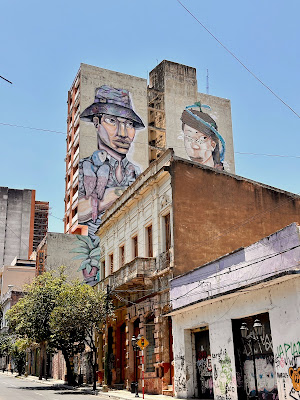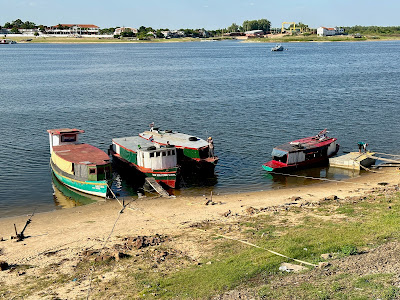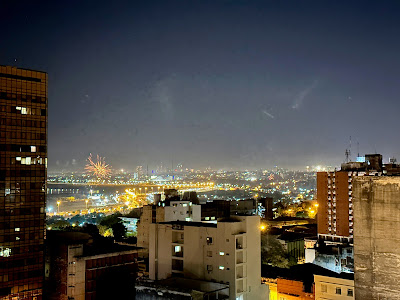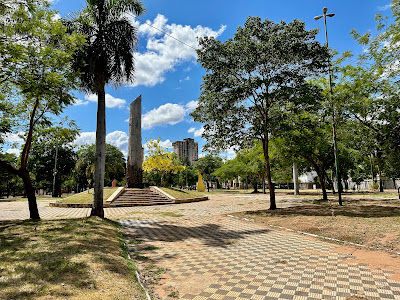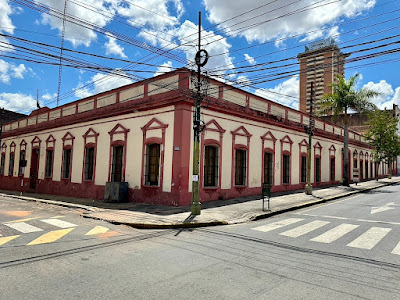Following on from my Antarctica trip and my short trip to Paraguay I went to Brazil for a few days. I flew from Asuncion, Paraguay to Sao Paulo arriving there late in the evening of Tuesday 3 January. I got a quick bite to eat at the airport before getting an Uber to my hotel - a nice one, a Hyatt.
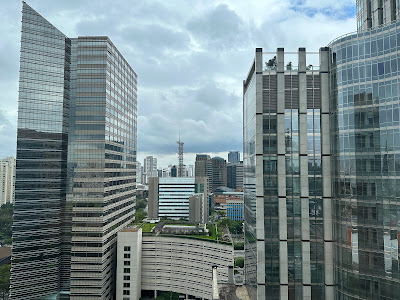 |
| View from the hotel in Sao Paulo |
The next morning it was a gray and rainy day. Not at all conducive to exploring Sao Paulo. I had a leisurely breakfast in the hotel and then set off to explore a little. One good thing about Sao Paulo is that all bus and train transport in the city is free to those over 65. So I just got on the bus and showed my Drivers License and that allowed me to travel wherever I wanted. It wasn’t so much the saving of money as the ease of not having to figure out how much the tickets cost, where to buy them, dealing with a foreign currency, etc.
 |
| Near Iburapuera Park, Sao Paulo |
I took a bus from outside the hotel towards the center of the city. It is such a huge city and I wasn’t at all sure of where I was going. I got off at a park, Ibirapuera Park, where there is a modern art museum.
 |
| Sao Paulo Cathedral |
The next day, it was also raining again. After breakfast it had stopped for a while and I ventured into the center once more. This time I got the bus to the Cathedral square. The Cathedral is quite impressive and there was a mass going on at the time I was there. I enjoyed sitting in the back observing.
 |
| Mural in Sao Paulo |
In the square outside the Cathedral there was quite a large group of what might have been homeless people or just unemployed men hanging around. It was quite intimidating and didn’t feel safe.
I had a cup of coffee and a cake and then when the rain came down again and looked like it was going to continue for the rest of the day I found my way to the bus station and took a bus back to the hotel.
So it wasn’t the most wonderful visit to Sao Paulo - the weather didn’t cooperate and the city is just so huge. I had a ticket to fly from Sao Paulo to Manaus the next day and I was quite pleased to get out of the city.
The flight to Manaus was three separate flights. First to Belo Horizonte, then to Brazilia, and finally to Manaus. Belo Horizonte and Brazilia were both very modern airports and were very impressive. Manaus not so much but quite adequate.
I arrived in Manaus late at night and got an Uber to my hotel, the beautifully named Casa Perpetua Hotel d’ Charm. The hotel was in a wonderful old home that was very eclectically decorated.
I went out to find food only to find that the hotel was right next to the Opera House on the main square of the city. How fortuitous.
 |
| Still Christmas in Manaus |
I was also surprised that they were still celebrating Christmas in Manaus. Not so much Christmas as Three Kings Day which occurs 12 days after Christmas. The main square was decked with ornaments and lights and even late at night there were crowds of people walking around.
 |
| Street Cafe in Manaus |
I got a beer and some empanadas at a bar on the square and sat outside watching the people go by and listening to the live music coming from inside the bar. What a great introduction to Manaus after a not so great time in Sao Paulo.
 |
| Christmas Decorations in front of Opera House |
The next morning I was up early and took a walk around the city. As I said, the hotel was adjacent to the main square so I was right there next to the beautiful Opera House. I walked on without any particular destination in mind and eventually found myself at the Praca de Policia, a nice park next to the old police station. The police station now houses a museum. The park was well manicured and was being swept clean by a group of city workers. Very neat and tidy.
 |
| Praca de Policia |
Back at the hotel I had breakfast and tried to extend my stay there. Alas there were no rooms available but they did have a sister hotel closer to the Opera House, the Casa dos Frades. Frades means friar or monk and the hotel was next door to the Cathedral.
 |
| Teatro Amazonas from the Hotel |
After moving down to my new hotel I bought a ticket to tour the Opera House. It was an English tour and I was the only one on it so I had a private tour. The Opera House or Teatro Amazonas as it is known, was built when Manaus was the center of the rubber boom and there was lots of money around. Construction was started in 1884 but the theater was not opened until 1896. It is a truly splendid building.
 |
| Interior Teatro Amazonas |
The building materials were all imported from Europe - marble from Italy, roof tiles from France, steel from Scotland, interior furnishings from France. There was a air ducting system them funneled cooler air from outside into the auditorium and released it in vents under the seats. Caruso sang there as did Pavarotti.
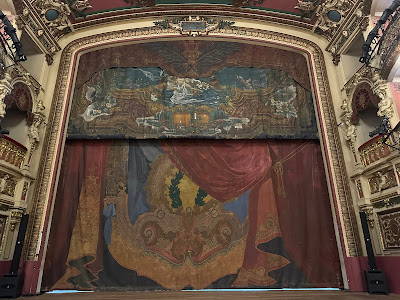 |
| The Stage and Curtain - Teatro Amazonas |
In the age of horse drawn carriages they were worried about too much noise from passing carriages so they had special tiles made using the local rubber that deadened the sound of the wheels and the horses hooves. A section of these tiles is still present.
 |
| Palace of Justice |
Next stop was the Palace of Justice, another impressive building behind the Opera House. I got a tour from one of the attendants there who spoke reasonable English. It is a beautiful building and the interior offices and courtroom had some wonderful old wooden furnishings.
 |
| Port of Manaus |
I next walked down to the port area where there were many large riverboats waiting to take passengers to the surrounding area - as far as Belem to the east and Iquitos the west. It is the easiest and cheapest mode of transportation in the area. Passengers bring their hammocks and string them up in the open deck areas. I booked a trip on a tourist boat to see the meeting of the rivers and various other sites for next Monday.
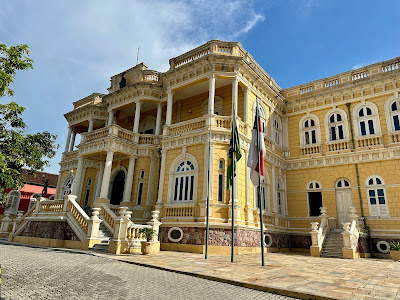 |
| Palacio Rio Negro |
I then walked to the Palacio Rio Negro which was the home of one of the richest rubber barons, the German born Waldemar Scholz. It became the Governor's Mansion for many years and now is open to the public as a museum of the Belle Epoque period.
A nice dinner in the evening at one of the finest hotels, the Opera. I had some amazing ceviche from the local Aruana fish.
 |
| Three Kings Night Celebrations |
In the evening there were thousands of people in the Opera Square celebrating Three Kings day. What an amazing party - music, dancing, food, and literally thousands of people.
 |
| Three Kings Night Celebrations |
I don’t know what time the party stopped that night, it was still going on close to midnight. The next day, Sunday, I went out to the Museum of the Amazon or MUSA as it is known as. This is a park just outside the city where the wonders of the Amazon jungle can be experienced. There are walks through the jungle, exhibits for snakes and spiders, a tower so you can climb above the treetops.
 |
| In the Museum of the Amazon |
I had just been into the arachnid house to see all sorts of fearsome spiders in glass cages when I was walking down the trail and I saw a big brown thing scuttle across the path ahead of me. When I got to that part of the trail I saw in the undergrowth a magnificent giant spider. It was a Aranha Golias or Goliath Birdeater, a member of the tarantula family. What a magnificent specimen. It was stationary and well camouflaged in the leaves and twigs. I took some pictures and then perhaps I got too close and it darted off further into the undergrowth, scaring the daylights out of me, it moved so fast.
 |
| The Goliath Birdeater Spider |
The tower was interesting. It had platforms at three different levels, the top one 140 ft above ground looking down on the jungle below - quite impressive.
 |
| High Water Marks for the Amazon |
Down at the port again I noticed that there was a record of the high water levels of the Amazon over the last 100 or so years. Of course it was quite clear that the high water marks for all the recent years were well above those of an earlier time. There’s global warming for you.
 |
| The Meeting of the Waters |
The next morning it was time to take the boat trip from the harbor. There were maybe 30 or so people on the boat and we embarked from the dock at the port. First we motored downstream past the industrial areas of Manaus to the confluence of the Amazon and the Rio Negro. Manaus is on the Rio Negro but just outside of the city it joins with the Amazon. Where the waters meet there is a distinct line of the dark water of the Rio Negro and the muddy brown water of the Amazon. Because the two rivers are a different density, different temperature and a different flow rate they do not immediately mix and there is a sharp delineation between the two flows for several miles downstream.
 |
| Pirarucu |
We then motored upstream for a short distance to some small floating buildings where we were given the opportunity to see some giant fish. The Pirarucu is a large freshwater fish, in fact the largest freshwater fish, and it can be in excess of 6ft long. The floating huts had crude ponds contained in them where several of these fish were kept captive. The locals had crude fishing poles with pieces of fish tied to the end of the strings. The idea was to hold the fish parts just on top of the water and the pirarucu would snap the fish off the line in a lightning fast snap of their mouths. They are indeed very impressive fish. Good eating too I am told.
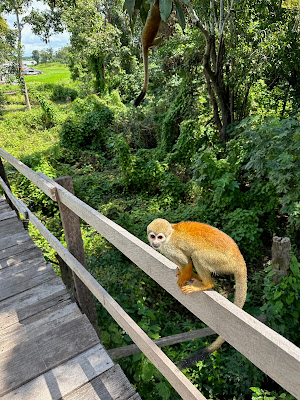 |
| Monkeys begging for treats |
After we had become tired of watching the fish perform we moved on to an area where there was a walkway through the jungle. This was quite an interesting area. There were several monkeys in the trees and they had become adept at begging for treats from the visiting tourists. They were quite cute and quite used to human contact. There were some amazingly large trees - one in particular, a ceiba or kapok tree. Also in a lake are some huge water lily pads.
 |
| Ceiba Tree |
At this point it was lunch time and we were due to visit a floating restaurant but before we could disembark the wind whipped up and the rain came down. It was just too risky to put out into the river in such weather so we stayed tied up for a while until the wind had died down.
 |
| Storm Clouds brewing |
When the winds died down a little we motored over to where the floating restaurant and tied up there. We had a nice buffet lunch of fish, chicken and rice and then set off once more. This time to visit a native village.
 |
| Natives dancing for the tourists |
We moored the boat in a small inlet of the main passage and walked up a very muddy trail to a village sitting above the present river level up a slight hill. Probably the village was built above the high water level in rainy season.
I don’t like these sort of shows put on by natives for the benefit of tourists. It always seems a bit demeaning. Sure it is interesting to see how they live or perhaps these days lived but we don’t need to see them performing for tourist dollars. Anyway they didn’t ask me and so I had to go along. There were photo opportunities with the wild life - caymans, sloths, pythons, monkeys. There were dancing exhibitions and face painting. Quite embarrassing.
 |
| The new Rio Negro Bridge |
Back on the boat we then motored a good ways up the Rio Negro, past Manaus, under the big road bridge over the river and tied up alongside more floating cabins. This was the chance to see the pink dolphins. I thought at first the dolphins might be captive but no, they were free swimming. The hosts slapped the water with planks of wood to make a sound that the dolphins associated with feeding time and then folks got into the water while one of the hosts held up fish for the dolphins to come to the surface and eat. A lot of folk went in to swim with the dolphins (not really swimming but more bobbing around in the water) but I resisted (easy when I didn’t have a towel.
 |
| Swimming with the Pink Dolphins |
Back in the boat again, we returned to the dock in Manaus. The native village visit was a bit contrived and unnecessary, and the dolphin swim would have been better if we just observed the dolphins but all in all it was an interesting day trip.
 |
| The old public market |
There is an old market from the early 1900’s that is quite a beautiful building and then there is a larger more modern market that is not so attractive but probably more appropriate for today’s environment. I enjoyed walking through the markets, particularly the fish vendors. Fish are a staple of the diet there and there are some wonderful creatures they fish out of the Amazon and Rio Negro.
 |
| Fish Market |
It started to rain so it was not the best of times to walk the streets. I went to the Palacio Provencal which now houses a museum and art gallery. That provided a nice escape from the rain. The art gallery was surprisingly quite good. There were also exhibits in the museum of military paraphernalia from the Colonial times, and then for some reason an impressive collection of old coins from around the world.
I went back to the hotel to dry out and get ready to go to the airport. The first flight was to Brasilia where there was a long (3 hr) layover before the flight to Sao Paulo. I arrived in Sao Paulo at 1:00 am and got a room at an airport hotel, in Guarulhos. The next day it was still raining so I killed time in the hotel before going to the airport again for my evening flight to Chicago and then home to Sacramento.
There are more photos here.



